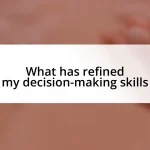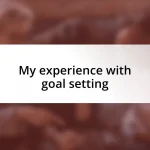Key takeaways:
- Active listening involves engaging fully, including listening without interruptions and asking clarifying questions to deepen the connection.
- Nonverbal communication, such as eye contact and body language, significantly enhances the effectiveness of active listening.
- Using open-ended questions encourages deeper sharing and reflection, transforming superficial conversations into meaningful dialogues.
- Providing constructive feedback with a positive tone fosters trust and collaboration, making others more receptive to input.

Understanding active listening skills
Active listening skills go beyond just hearing words; they’re about fully engaging with the speaker. I remember a time when a friend confided in me about their struggles. Instead of jumping in with advice, I simply listened, pausing to reflect and ask clarifying questions. This not only made them feel heard but deepened our connection.
When I think about the power of active listening, it often raises the question: How often do we truly give our full attention to others? I’ve found that distractions like our phones can easily pull me away from meaningful conversations. One day, I decided to leave my phone in another room while chatting with a colleague, and I noticed a remarkable shift. It was as if we were both more present, and our dialogue flowed more naturally.
One essential aspect of active listening is nonverbal communication. I’ve noticed that a simple nod or a warm smile can encourage the speaker to share more freely. During a recent team meeting, I focused on my body language, leaning in and making eye contact. The result? My colleagues opened up more, and we had one of the most productive discussions we’ve ever had. It’s amazing how small adjustments in our approach can create a more inviting atmosphere for conversation.

Importance of nonverbal communication
Nonverbal communication plays a crucial role in active listening. I remember attending a workshop where the facilitator emphasized how our body language speaks volumes, even when we stay silent. There was a moment when a fellow participant shared a deeply personal story, and the facilitator simply leaned in, maintaining eye contact without interruption. The room felt charged with empathy, illustrating how our nonverbal cues can make the speaker feel truly valued.
Reflecting on my own experiences, I’ve discovered that posture and facial expressions significantly impact conversations. Once, during a disagreement with a friend, I crossed my arms and looked away, which made the situation tense and frustrating. However, when I consciously relaxed my body and nodded occasionally, the emotional climate shifted. It turned what could have been an angry outburst into a constructive dialogue. I learned that such small changes can foster mutual understanding and openness.
In my opinion, the subtleties of nonverbal communication convey emotions that words sometimes can’t capture. I often find myself smiling brightly or using gestures to reinforce my engagement. For instance, during a casual catch-up with a close friend, I made sure to lean forward with genuine interest while they recounted their recent adventures. This simple act fostered a warm atmosphere that encouraged them to share even more, highlighting how powerful our nonverbal signals can be in facilitating connection.
| Nonverbal Cues | Effects on Communication |
|---|---|
| Eye Contact | Builds trust and shows attentiveness |
| Posture | Reflects confidence and openness |
| Facial Expressions | Conveys emotions and reactions |
| Nodding | Encourages the speaker to continue talking |
| Gestures | Reinforces the message being communicated |

Techniques for enhancing focus
Focusing during conversations can be challenging, but I’ve discovered a few techniques that work wonders for me. One approach I’ve loved is practical mindfulness. I often take a moment before a discussion to clear my mind, visualizing myself as fully attentive. This mental reset helps me shake off distractions, allowing the conversation to unfold seamlessly.
Here are some techniques that enhance my focus:
- Limit Distractions: I keep my phone out of reach or disable notifications during conversations. I’ve found that this simple act cultivates a more enriching environment.
- Mindful Breathing: Before engaging, taking a few deep breaths calms my mind and prepares me to listen intently. It’s amazing how much this small practice can anchor me in the moment.
- Summarizing: I frequently summarize what the speaker has said to reinforce my understanding. Just last week, I paraphrased my partner’s thoughts during a discussion, and it led to deeper insights from both sides.
- Engage with Curiosity: Adopting a genuine curiosity about the speaker’s perspective fuels my engagement. I often ask follow-up questions, which not only clarifies points but also shows that I value their input.
Embedding these techniques into my daily interactions has transformed the quality of my conversations, leading not just to improved focus but also to stronger relationships. Each moment spent genuinely connecting feels more enriching, and it’s a shift I’ve cherished profoundly.

Asking effective open-ended questions
Asking effective open-ended questions is a game changer in any conversation. I remember a time when I was catching up with an old friend who had been going through a challenging time. Instead of a simple “How have you been?” I asked, “What has been on your mind lately?” This shift opened up the floor for them to share their thoughts and feelings in a way that felt safe and inviting. It’s incredible how such a small tweak can lead to more meaningful conversations.
What fascinates me about open-ended questions is how they encourage others to reflect and express themselves more deeply. A few months ago, while mentoring a colleague, I asked, “What challenges are you facing in your project, and how do you feel about them?” This prompted a rich discussion full of insights and emotions that we might have glossed over with closed questions. It reminded me that probing into feelings can not only uncover essential details but foster a sense of connection.
Have you ever noticed how a well-placed open-ended question can transform a conversation from superficial to deeply engaging? It’s almost like opening a door to a room filled with thoughts and experiences the speaker has been waiting to share. When I find myself genuinely curious about someone else’s journey and ask questions that reflect that curiosity, I notice the quality of our interaction improves significantly. Those moments have taught me that asking with intention can lead to some of the most rewarding conversations I’ve ever had.

Providing constructive feedback
Providing constructive feedback is a delicate art that can significantly enhance communication. I recall a team meeting where I was tasked with evaluating a colleague’s presentation. Instead of simply pointing out what didn’t work, I made sure to highlight what I appreciated first. This approach not only made my feedback feel more balanced but also fostered an atmosphere of trust, allowing my colleague to feel open and receptive.
In another instance, I had a friend who struggled with a new project at work. After listening attentively to her concerns, I shared my thoughts in a way that felt supportive rather than critical. I asked, “How do you think we could tweak your approach to better align with your strengths?” This shifted our conversation from a focus on problems to collaborative problem-solving, inviting her to take ownership of her challenges while feeling empowered by my support.
Have you ever noticed how the tone of your feedback can change the entire conversation? I find that when I approach feedback with positivity, others are more willing to accept it and make changes. By framing my suggestions as opportunities for growth rather than criticisms, I’ve seen people flourish in their roles. This reinforcing cycle of constructive feedback has been an invaluable part of my active listening journey.

Practicing active listening in conversations
Practicing active listening in conversations goes beyond just hearing words; it’s about fully engaging with the speaker. I remember having a heart-to-heart with a close friend during a tough period in her life. As she spoke about her frustrations, I focused not just on what she was saying, but how she was feeling. By maintaining eye contact and nodding in understanding, I felt her relief when she realized I was truly there for her – it was a defining moment that emphasized the importance of being present.
I often find that the way I respond to someone can sustain the momentum of a conversation. One evening, while chatting with a family member, I noticed they resorted to vague statements. Instead of letting that slide, I responded with, “That sounds challenging; can you share more about what made it tough?” This seemed to light a spark in them, revealing emotions that were previously tucked away, and it reminded me how acknowledging the emotional undertones can elevate a simple exchange into something more profound.
Isn’t it interesting how our responses can encourage deeper dialogue? I’ve learned that sometimes just pausing for a moment before replying can create space for the other person to continue. I’ve had instances where someone would start to share again after my silence, as if they were weighing whether to delve deeper. These experiences have taught me that active listening isn’t merely about what we say; it’s also about creating an inviting atmosphere where others feel comfortable sharing in their own time.

Measuring your listening progress
Measuring my listening progress is an essential part of honing my active listening skills. I set aside time to reflect after conversations, asking myself questions like, “Did I truly understand what the other person was trying to convey?” and “How well did I read their emotional cues?” This self-assessment often reveals the subtle gaps in my listening approach, prompting me to adjust my techniques accordingly.
One particularly eye-opening moment came during a casual chat with a coworker. After we wrapped up, I realized I hadn’t asked enough follow-up questions. I felt a bit disappointed because I was eager to learn more about their perspective. This revelation motivated me to not just listen, but also actively encourage deeper sharing in future conversations.
Over time, I began tracking patterns in my interactions, noting instances where I felt connected versus those where the dialogue felt surface-level. I discovered that when I proactively sought feedback from others about how they felt during our conversations, it opened up a new layer of understanding. Hearing phrases like, “I felt heard” or “I appreciate how you asked about my feelings” underscored the positive changes I was working on—and that was incredibly validating. How do you measure your progress? It can be as simple as tuning into the emotional resonance in your conversations!












